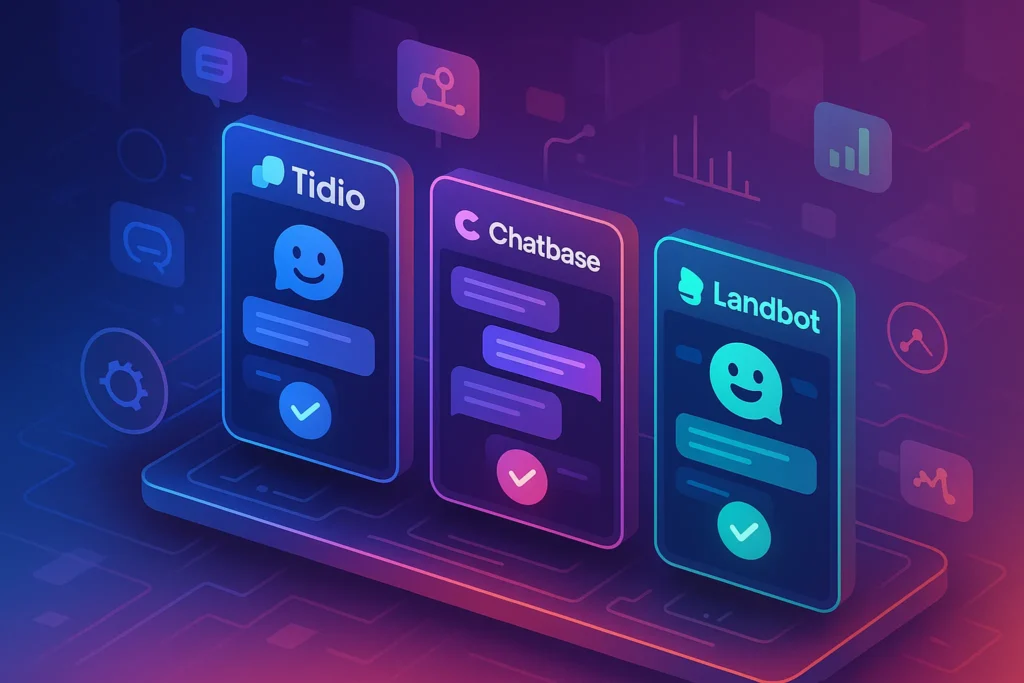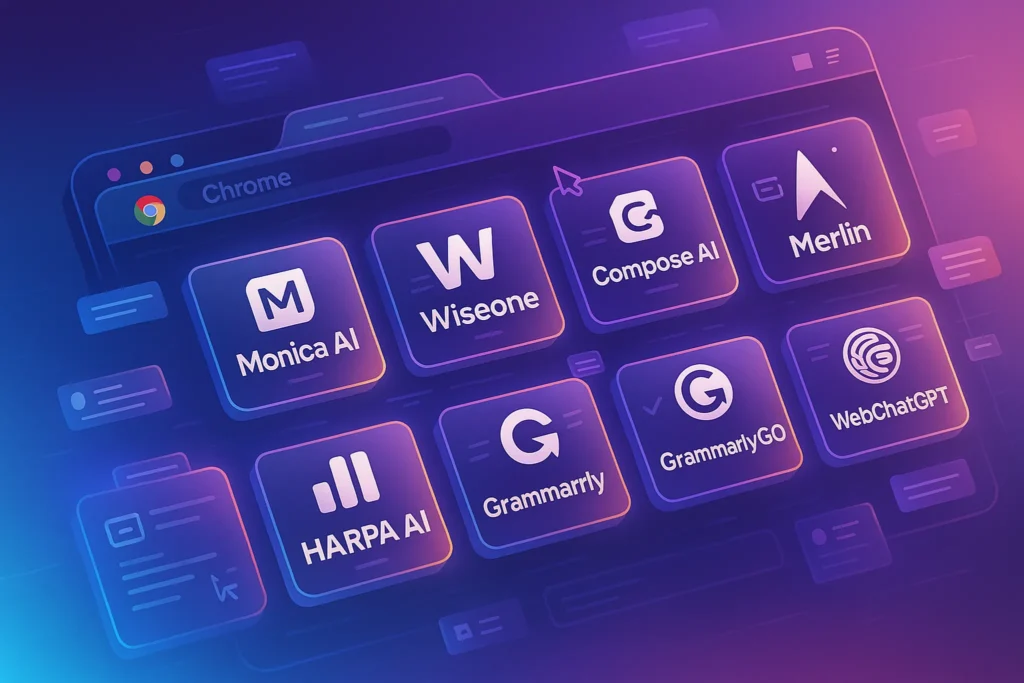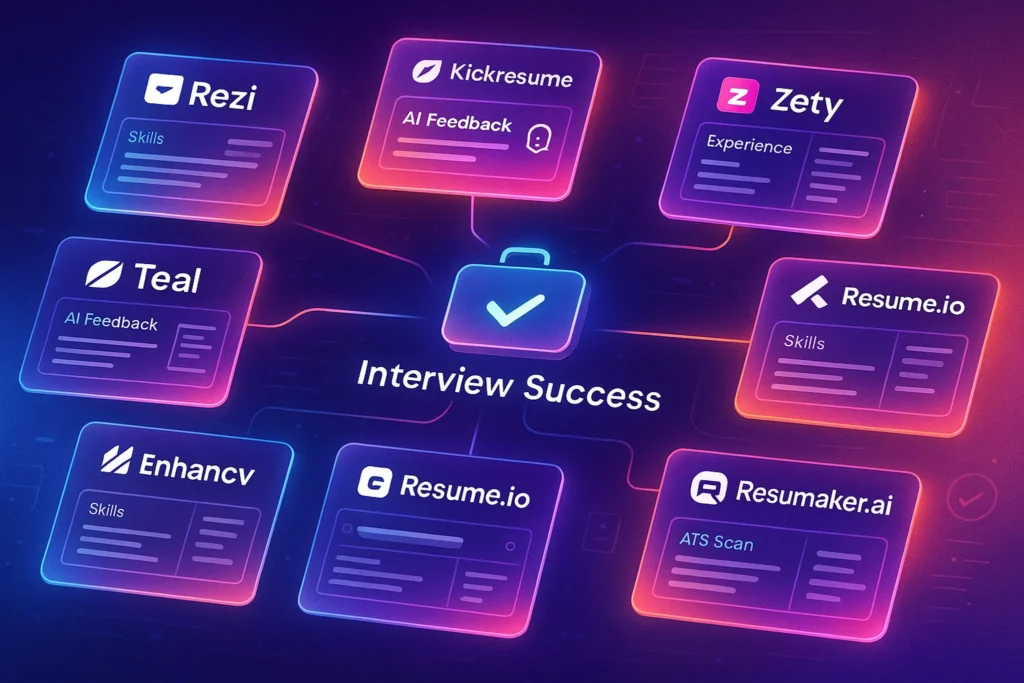-This post may contain affiliate links. If you click on one and make a purchase, I may earn a small commission at no extra cost to you.-
🤖 Introduction: Building Smart Chatbots Just Got Code-Free
In 2025, building an AI chatbot doesn’t require a single line of code. Whether you’re a solopreneur, a customer support manager, or a content creator, there are now dozens of powerful platforms that let you create, train, and launch AI-powered chatbots in minutes — often for free.
But with so many tools claiming to be “smart” or “GPT-powered,” how do you choose the right one?
This guide breaks down the top AI chatbot builders of 2025 — focusing on tools that are easy to use, budget-friendly, and real-world tested. We’ll explore features, use cases, and what makes each one stand out (or fall short) — so you can launch your own assistant, helpdesk, or lead-gen bot without touching a single API.
AI chatbots are no longer optional—they’re expected.
In 2025, customers want fast answers, 24/7 support, and human-sounding AI that doesn’t drive them mad. Whether you’re running a SaaS site, an ecommerce shop, or a service-based brand, your chatbot is your first impression.
But here’s the catch: most people still use outdated, clunky bot builders.
We’ve tested the smartest, most intuitive chatbot builders that are dominating 2025—from plug-and-play solutions to GPT-powered assistants.
Let’s break down the best ones for your site—and your goals.
🤖 Top AI Chatbot Builders Worth Trying
🟢 1. Tidio AI – Smart Chat for Smart Brands
Tidio has evolved into a powerful all-in-one chat + automation platform. With its Lyro AI chatbot, you can train your bot on your help center or product pages, and it will answer customer questions in real-time using natural, contextual responses.
It also supports multichannel chat, human handoff, and advanced triggers to increase conversions.
💬 “I used Tidio on a niche dropshipping store. It handled 70% of incoming chats on day one — and even suggested a bundle to a customer that boosted AOV.”
Real-world Use Case:
Imagine a Shopify store selling personalized gifts. Tidio not only answers “Where’s my order?” queries instantly, but also upsells complementary items with custom product carousels. A visitor asks about gift-wrapping → Tidio suggests a $9 add-on → conversion!
Compared To:
Unlike Drift or LiveChat, Tidio doesn’t lock AI behind enterprise pricing. It delivers GPT-style responses on even lower-tier plans.
⚖️ Mini Comparison: Easier to set up than ManyChat, more AI-focused than Intercom.
What it does: Tidio combines live chat + AI-powered automation in one. It uses Lyro, its own conversational AI engine, and integrates with email, Messenger, and Instagram.
Best For: Ecommerce sites, small businesses, Shopify stores
Why It’s Great: Pre-built flows for customer support, cart recovery, and FAQ handling
Key Features:
-
GPT-powered responses
-
Human fallback handover
-
Shopify, Wix, WordPress integration
-
Mobile-friendly UX
🧠 Nerd Verdict: “Tidio is the Drift-killer for startups.”
🟦 2. Botpress — Best for Technical Users Who Still Want a UI
Botpress is an open-source platform with a drag-and-drop editor and deep logic control. It’s best for users who want complete customization without needing to write code — though it does support scripting if needed.
Botpress is ideal if you want your bot to do more than just reply — like take actions, do conditional logic, and integrate into backend systems.
💬 “Botpress gave us the control of a developer platform without needing full-time devs. It’s like the WordPress of chatbot logic.”
Real-world Use Case:
A SaaS founder builds a customer success bot that auto-detects sentiment in user queries (via NLU) and routes complaints to Slack, while easy questions get GPT-based answers instantly.
Compared To:
Dialogflow or Rasa offer similar flexibility but lack GPT-native support out-of-the-box. Botpress bridges that gap without a learning cliff.
⚖️ Mini Comparison: Less user-friendly than Tidio, but far more powerful in logic than Chatbase or Chatfuel.
What it does: A developer-friendly bot builder using modular flows, AI/NLU, and GPT integrations. Fully open-source with paid SaaS options.
Best For: Tech-savvy marketers, SaaS founders, custom UX cases
Why It’s Great: Deep customization + built-in analytics + open AI connectors
Key Features:
-
Visual flow editor
-
Human handoff logic
-
Multilingual AI
-
Voice-enabled options (beta)
🧠 Smart Jab: “Build once, deploy everywhere—with code-level freedom.”
🟡 3. Chatbase – GPT Chatbots Trained on Your Content
Chatbase lets you build a ChatGPT-like assistant by uploading your content — PDFs, URLs, or even Notion docs. It’s ideal for businesses who want a custom-trained chatbot without coding.
You can embed it anywhere or use it as a standalone page, and tweak how “smart” or “strict” it is.
Looking to take automation further? Don’t miss our guide on Zapier Automations for Creators to connect your chatbot with email, CRM, and task flows.
Real-world Use Case:
A coaching site uploads its entire Notion knowledge base → Chatbase trains the bot → Clients now ask questions like “What’s your refund policy?” or “Can I reschedule a session?” and get branded, on-tone answers in real time.
Compared To:
Chatbase is a leaner, more no-code version of OpenAI’s own assistants—and easier to embed in sites.
⚖️ Mini Comparison: More customizable than Tidio, less “live-chat”-like than Botpress.
What it does: Upload your website or docs, and Chatbase trains a GPT-powered chatbot that responds like your brand voice.
Best For: Content-rich brands, SaaS, help centers
Why It’s Great: No coding, no training—just upload and go.
Key Features:
-
Embed anywhere
-
Customizable tone
-
API + Zapier integration
-
Analytics dashboard
🧠 Use Case: “Turn your entire FAQ page into a 24/7 support agent.”
🟣 4. Landbot – No-Code Visual Bot Builder
Real-world Use Case:
A freelance marketing consultant builds an onboarding bot: asks client goals, budget, timeline → qualifies leads in chat → syncs responses to Google Sheets and books a Calendly slot.
Compared To:
Manychat and MobileMonkey lean social; Landbot nails web-based UX with granular flow control.
What it does: Landbot lets you build beautiful conversational experiences without writing a line of code. It works on websites, WhatsApp, and Messenger.
Best For: Lead gen, onboarding flows, service-based businesses
Why It’s Great: Drag-and-drop logic with pixel-perfect design controls
Key Features:
-
Conditional logic
-
A/B testing built-in
-
WhatsApp + Web embeds
-
Templates for lead gen, quizzes, product tours
🧠 Smart Note: “If your funnel had a face, Landbot would design it.”
🔵 5. Intercom Fin AI – The Enterprise Chatbot Goes GPT
Real-world Use Case:
A SaaS platform integrates Fin with its knowledge base + support center. Over 70% of tickets are now auto-resolved without human input—reducing first-response times from hours to seconds.
Compared To:
Unlike legacy Intercom bots, Fin learns fast, adapts tone, and leverages GPT to avoid “robot talk.”
What it does: Intercom now includes Fin—an AI chatbot powered by GPT that handles support tickets, FAQs, and onboarding at scale.
Best For: SaaS companies, startups, enterprise CX teams
Why It’s Great: Deep CRM + knowledge base integration
Key Features:
-
Fin learns from your help center
-
Smart fallback to human agents
-
Integrated with email, inbox, CRM
-
High data privacy compliance (GDPR, SOC2)
🧠 Nerd Verdict: “If you’re serious about support, Fin is your frontline soldier.”
🟢 6. Crisp Chat + GPT Plugin
Real-world Use Case:
A startup integrates Crisp across web, mobile, and email. With the GPT plugin trained on their docs, support reps only answer 20% of tickets manually. Crisp handles the rest—and sends insights to Notion.
Compared To:
Crisp is often seen as the “affordable Intercom.” But with GPT, it becomes a smart hub for lean support teams.
What it does: Crisp is a multi-channel messaging platform that now offers GPT plugins—combine AI with live chat, email, and CRM.
Best For: Mid-size teams, sales + support hybrid needs
Why It’s Great: Affordable alternative to Intercom with deep customization
Key Features:
-
Chat triggers + workflows
-
GPT plugin + docs training
-
Mobile apps for teams
-
Knowledge base + CRM built-in
🧠 Use Case: “The best choice for growing SaaS teams with small budgets.”
7. ManyChat — Best for Lead Generation on Instagram & WhatsApp
If your goal is lead capture and engagement on messaging apps, ManyChat still dominates. Its AI assistant builder now integrates with GPT to provide smart replies, but its real power is in its flow builder, conversion tracking, and integrations with Facebook, WhatsApp, and IG DM.
👥 Use-Case: A personal brand or local business doing Instagram DM campaigns.
⚖️ Mini Comparison: Great for social channels, but less AI-native than Chatbase or Tidio.
🎁 Bonus: CustomGPT — Best for Branded AI Assistants
CustomGPT is designed for those who want to create a fully-branded GPT assistant — with control over voice, tone, and training data. Unlike Chatbase, it offers fine-tuning options, branding controls, and analytics dashboards.
Great for agencies, startups, and creators building white-label bots or internal tools.
👤 Use-Case: A digital marketing agency building a branded chatbot for multiple clients.
⚖️ Mini Comparison: More powerful than Chatbase in branding, but more expensive if scaling across clients.
🎁 Bonus Tip: How to Choose the Right Chatbot for Your Needs
-
For eCommerce: Tidio or ManyChat
-
For Developers: Botpress or Chatbase
-
For Lead Gen Funnels: Landbot
-
For low-budget projects: Flow XO or SendPulse (free plans available)
🎁 Bonus: What to Look for in a Chatbot Builder (2025 Edition)
-
✅ GPT-powered with adjustable temperature
-
✅ Content upload or URL indexing
-
✅ Live handoff options to human agents
-
✅ Multi-platform support (embed + chat apps)
-
✅ Affordable plans or freemium access
-
✅ Analytics + feedback loop for training
📊 All Chatbots in a Glance – 2025 Showdown
| Tool | Best For | GPT Integration | No-Code | Channels |
|---|---|---|---|---|
| Tidio AI | Ecommerce & SMBs | ✅ Lyro (GPT-based) | ✅ | Web, IG, FB |
| Botpress | Devs & Custom UX | ✅ GPT connectors | 🔶 Partial | Web, Voice |
| Chatbase | SaaS & Help Centers | ✅ Full GPT | ✅ | Web Embed |
| Landbot | Lead Gen & Funnels | 🔶 API via GPT | ✅ | Web, WhatsApp |
| Intercom Fin | Enterprises & SaaS CX | ✅ Fin AI | 🔶 Partial | Inbox, CRM |
| Crisp GPT | Mid-size SaaS/Support | ✅ Plugin-based | ✅ | Chat, Email |
💡 Pro Tips for Choosing the Right AI Chatbot
-
🎯 Pick Based on Workflow, Not Features: If you need lead gen, go Landbot. For 24/7 support, Chatbase or Tidio is better.
-
🔄 Test Before You Commit: Most offer free tiers or demos. Run a week-long live test and track real questions.
-
⚙️ Integrate with Your Stack: Choose tools with direct connections to your CRM, email platform, and analytics.
🛠️ Pros & Cons of AI Chatbots in 2025
✅ ProsTop AI Chatbot BuildersTop AI Chatbot Builders
-
24/7 customer support with human-like accuracy
-
Huge reduction in support ticket load
-
Collect leads + onboard users faster
-
Easy A/B testing for funnels
❌ Cons
-
Chatbots still struggle with complex logic or emotions
-
Setup takes time if training on large data
-
AI hallucination risk without tight content control
🧠 Nerd Verdict: What I’d Personally Use
“If I’m launching a product today, I’d use Chatbase for an FAQ-trained GPT bot, and Tidio if I want live chat + AI in one.
For clients? CustomGPT if they care about brand tone. For IG/DM campaigns? ManyChat still wins.”
It’s not about the flashiest tool — it’s about what fits your flow.
❓ FAQ – Quick Answers for Site Owners
Which AI chatbot is best for ecommerce?
Tidio AI is the best all-in-one for Shopify, with automation, AI replies, and Messenger integration.
Are these chatbots safe for user data?
Tools like Intercom, Crisp, and Chatbase follow strong privacy standards like GDPR and offer admin-level security.
Can I train these bots on my own content?
Yes! Chatbase, Botpress, and Crisp all allow you to upload docs, URLs, or FAQs to train custom GPT responses.
Are these tools really code-free?
Yes! All of them offer drag-and-drop or config-based logic. You can go deeper with APIs — but you don’t have to.
Do they all use ChatGPT?
Most use OpenAI APIs. Some like Botpress or CustomGPT allow model switching or fine-tuning.
Can I use one bot across my website and social media?
Depends. Tidio and ManyChat support multichannel, others are best for web/chat-only.
💬 Would You Bite?
If you had to add an AI chatbot to your site this week—which one would you try first?
Drop your pick below. Let’s compare nerd notes. Let us know below or tag us on X 🤖👇



